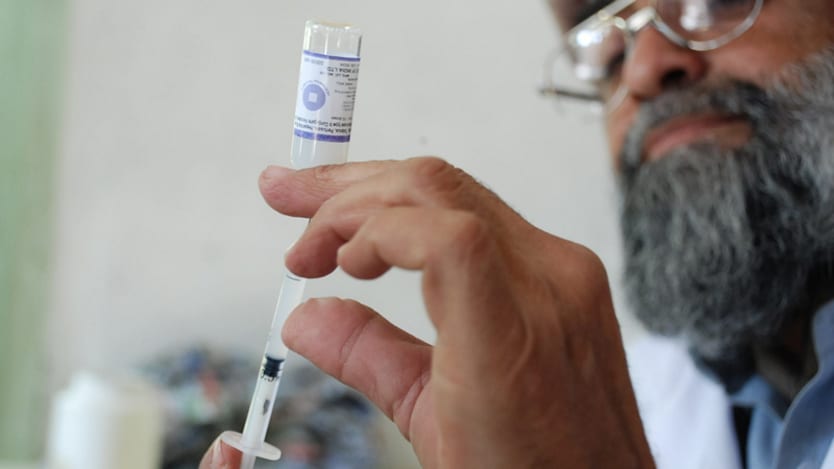
The ancient soldiers of Sparta understood the value of linking their shields together to form a larger protective shield. Imagine how vulnerable those soldiers would have been if one out of every five lacked a shield. Imagine the gaping holes in the formation where arrows and spears might have made it through and jeopardized the protection of the rest. Like the shields of Sparta, vaccines protect each of us from an onslaught of deadly viruses and bacteria. And like those military formations, vaccines work best when everyone has a shield and we all protect each other.
Each year, the World Health Organization and UNICEF issue a status update on how strong our shield is against selected infectious diseases in each country when they release their annual report of estimates of global immunization coverage. As two professionals who have spent their careers working to protect people from preventable infections, we see this report as an important North Star for our work.
Here’s what we see in this year’s report: overall high but stagnating levels of protection, with a few places where there are as many people unprotected as protected, and some alarming holes in protection in unexpected places. One of the most important findings from the report is that we are not reaching one out of every 10 infants worldwide with any of our vaccines. They are simply falling outside of our protective net. And although 86 percent of the world’s children are now completing the three-dose diphtheria-tetanus-pertussis (DTP3) vaccine annually — a standard measure of strength for country immunization programs and higher than nearly every other global health intervention — coverage has stagnated for the past seven years. On a really difficult high school science exam, an 86 percent score might be considered pretty good. In the field of global health and security, 86 percent of people protected is just not good enough. Anything less than 100 percent means people are unnecessarily at risk of death, disability and suffering.
Not surprisingly, many of the countries with the lowest levels of protection are some of the poorest countries, many of which are also entangled in conflict. But the challenges of lower protection are not isolated to developing countries, as one might think, and the consequences often cross borders. Take measles, one of the most easily transmitted infectious diseases in the world. Although a highly effective and safe vaccine was developed more than five decades ago — and around the world deaths due to measles have been reduced by over 80 percent — measles outbreaks in the U.S. and Europe and related child deaths have shown how easily vaccine-preventable diseases can reemerge when children are not vaccinated. Italy, for instance, has confirmed more than 3,300 cases and Romania has experienced 31 deaths. It is sobering to realize that measles immunization rates within the immigrant Somali community in Minnesota in 2014 were 42 percent, a rate even lower than the war-torn country of Somalia in 2016 (46 percent).
Conflict and fragile states also show up as a major driver of these results. It’s perhaps not surprising, but the data demonstrates that the majority (75 percent) of children unvaccinated with the basic package of vaccines are concentrated in places where conflict is common and governments are weak, and where extreme poverty and poorly functioning health systems contribute to stagnation or even decline.
See more related stories:
▶ Q&A: Rajeev Venkayya on why vaccines are a worthy investment
▶ Opinion: Embrace the facts — not the myths — about vaccines
▶ Opinion: Rethinking immunization strategies to reach the urban poor
Amid the stagnation and even regression in some countries, a clear positive has also emerged this year: better, more accurate data. For the first time at the global level, WHO and UNICEF received immunization coverage data at the subnational level for 125 of 194 countries — 89 of which reported data even further down to lower administrative (“district”) levels covering a combined population of 88 million.
This change represents a huge leap forward in a remarkably short period. And countries like Nigeria deserve our highest praise for reporting the most accurate estimates of coverage, not the highest possible number. As a result, the Nigerian government, despite immense administration and security challenges, is better placed to map out gaps in coverage and respond appropriately. Nigeria’s courageous leadership demonstrates how serious commitment to reaching every child with immunizations starts with accurate data. We encourage other countries to follow Nigeria’s lead in taking charge of their own data and using it to improve the protection of their communities.
The world has made tremendous strides in recent years, and we are getting closer to ensuring that no child is left unreached by lifesaving vaccines. Childhood immunization also represents one of the best investments a country can make, producing $44 in economic and social benefits for every $1 invested. Immunization is an essential component of the armor that protects us from risks at home and abroad.
Yet, as this year’s report reminds us, we cannot let success lead to complacency and stagnation. We must continue to invest in vaccines and strengthen the systems that protect our communities. We must also commit to reporting the most accurate numbers, even if it is politically challenging and the numbers are not the most convenient ones. While these figures might reveal lower coverage rates in the near term, the information is essential for targeting our efforts to increase coverage and, like a collective Spartan shield, ensure that no child anywhere suffers from vaccine-preventable diseases.
Join the Devex community and access more in-depth analysis, breaking news and business advice — and a host of other services — on international development, humanitarian aid and global health.









